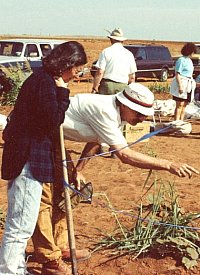
Geoarcheologist Vance Holliday points
out new evidence to TAS Field School Director Eileen
Johnson. Photo by E. Mott Davis.
|
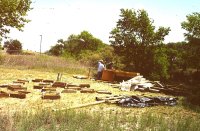
Water-screening to recover small
artifacts and bones at Lubbock Lake Landmark. Photo
by E. Mott Davis.
|
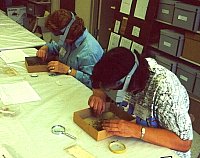
TAS volunteers don magnifying lenses
to spot the bones of tiny critters sensitive to environmental
and climatic change. Photo by E. Mott Davis.
|
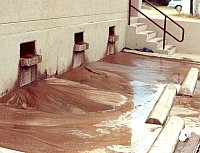
Where the dirt goes. Fine-screen
residue outside the laboratory. Photo by E. Mott Davis.
|
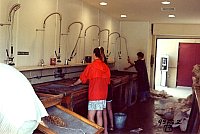
Fine screening special samples inside
the laboratory at the Landmark. Photo by E. Mott Davis.
|
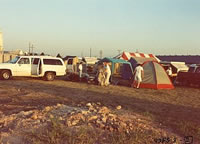
Setting up the TAS tent camp in the
late afternoon. Photo by E. Mott Davis.
|
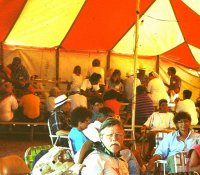
Inside the large circus tent that
served as the field school dining and lecture hall and
gave much-needed shelter on windy days. Photo by E.
Mott Davis.
|
|
These images were taken by various participant-photographers
at the 1993 Texas Archeological Society Field School at Lubbock
Lake. Sadly, two of the photographers, Dr. E. Mott Davis and
Norman Flaigg, are no longer with us. They were both beloved
TAS members who made many contributions to the society and
Texas archeology. Davis was Professor of Anthropology at UT
Austin, a man who embodied the Society's aim to bring professional
and avocational archeologists together to work as one. He
was a major presence at almost every TAS field school and
annual meeting: a teacher, friend, orator, and singer extraordinaire.
Flaigg came to archeology relatively late in life after a
career in military engineering, but he soon became one of
the most enthusiastic and effective archeological volunteers.
He was everybody's favorite crew chief at TAS field schools,
a teacher, friend, and gentle taskmaster. Both men donated
their photographic collections to TARL and would be pleased
to learn that the images they captured have been put to good
use.
TAS, now in its 73rd year, is one of the oldest
and most successful archeological societies in North America.
Annual field schools have been held at important archeological
sites throughout the state. To learn more about TAS and how
to become a member, visit www.txarch.org.
Vance Holliday and crew set up a coring
rig to take sediment samples of this locale outside Lubbock.
Such samples can reveal the layering of the deposits without
digging a huge hole. Photo by E. Mott Davis.
Excavations underway within the Lubbock
Lake Landmark preserve. Photo by Norman Flaigg.
Meanwhile, out in the bushes, a survey
crew pauses to pose for photographer E. Mott Davis.
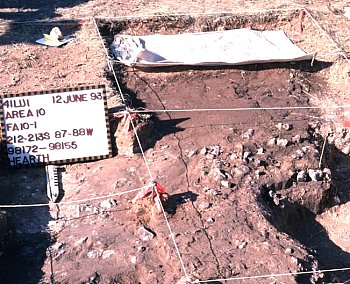
A hard-worn hearth, exposed and documented
by photographer Norman Flaigg's crew. This rather amorphous
cluster of fire-cracked caliche nodules is the scattered remains
of a prehistoric cooking fire.
|
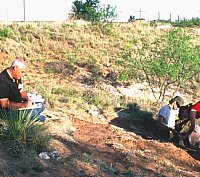
Jaq Jaquier takes note as TAS members
begin a new excavation at Lubbock Lake Landmark. Photo
by Norman Flaigg. Click images to enlarge
|
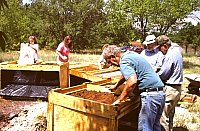
Water-screening to recover small
artifacts and bones at Lubbock Lake Landmark. Photo
by E. Mott Davis.
|
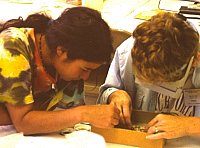
Taking a closer look. Photo by E.
Mott Davis.
|
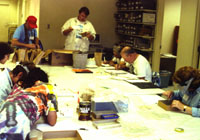
The lab crew, busy at work. Photo
by E. Mott Davis.
|
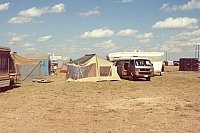
TAS tent camp on the Plains. Photographer
E. Mott Davis lived in the tent in the center of the
picture, the one with the sagging corner. No doubt it
was the wind.
|
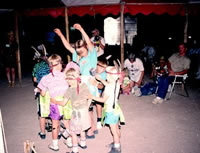
Children perform a dance at evening
under the big tent. Photo by Norman Flaigg.
|
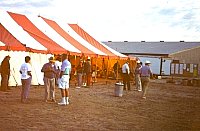
Outside the large circus tent that
served as the field school dining and lecture hall.
Photo by E. Mott Davis.
|
|